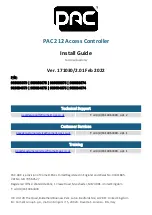
Wake on LAN Mode/Low-Power
BCM5718 Programmer’s Guide
Broadcom
®
January 29, 2016 • 5718-PG108-R
Page 217
Pattern Data Structure
The maximum number of entries in either 10/100 or 1000 mode is 128. The Ethernet controller cannot process
a pattern that requires more than 128 entries. The size of an entry will vary based on 10/100 or 1000 Mbps
mode. Additionally, all unused rows must be initialized with zeros. The WOL hardware cannot process an entry
unless unused rows and rules have been zeroed out (see
Figure 48: Unused Rows and Rules Must Be Initialized with Zeros
Frame patterns are stored as data structures in memory. A control word is always present in a 64 bit entry/row.
The control word describes proceeding data fields in the entry.
In 10/100 Mbps mode, one WOL entry requires three 64-bit wide rows (see
). The total length of an
entry is 192 bits. Each 64-bit row contains a 16-bit control word, which identifies byte enables (see
).
The remaining 48-bits contains 2-byte rules. The 2-byte rules are distributed across three streams: S, S+1, and
S+2. The next row’s 2-byte rules will correspond to three more streams: S+3, S+4, and S+5. Both
and
use Sx notation to denote separate comparison streams. The D0 notation indicates the first 2 bytes in
the packet stream are compared.
Table 75: 10/100 Mbps Mode Frame Patterns Memory
63
48 47
32 31
16 15
0
CTRL012
S0D0
S1D0
S2D0
CTRL345
S3D0
S4D0
S5D0
CTRL678
S6D0
S7D0
S8D0
Table 76: Frame Control Field for 10/100 Mbps Mode
Bits
Field
Description
Access
63:62 Reserved
61
S0 High Byte Enable
Enable S0 higher byte for comparison
RW
60
S0 Low Byte Enable
Enable S0 lower byte for comparison
RW
59
S1 High Byte Enable
Enable S1 higher byte for comparison
RW
USED
00,00
00,00
00,00
00,00
00,00
00,00
Control
Stream 1
Stream 2
Stream 3
00,00
00,00
Unused rules are
initialized with 0
















































